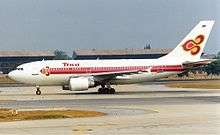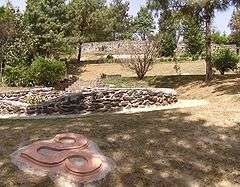Thai Airways International Flight 311
 HS-TID, the aircraft involved in the accident seen at Don Mueang International Airport in April 1992 | |
| Accident summary | |
|---|---|
| Date | 31 July 1992 |
| Summary | Controlled flight into terrain |
| Site | Langtang National Park, Nepal |
| Passengers | 99 |
| Crew | 14 |
| Fatalities | 113 (all) |
| Survivors | 0 |
| Aircraft type | Airbus A310-304 |
| Operator | Thai Airways International |
| Registration | HS-TID |
| Flight origin |
Don Mueang International Airport, Bangkok, Thailand |
| Destination |
Tribhuvan International Airport, Kathmandu, Nepal |
Thai Airways International Flight 311 was a flight from Bangkok, Thailand's Don Mueang International Airport to Kathmandu, Nepal's Tribhuvan International Airport. On Friday, 31 July 1992, an A310-304 on the route, registration HS-TID, crashed on approach to Tribhuvan. At 07:00:26 UTC (12:45:26 NST; 14:00:26 ICT), the aircraft crashed into the side of a mountain 37 kilometres miles north of Kathmandu at an altitude of 11,500 feet and a ground speed of 300 nautical miles per hour, killing all 99 passengers and 14 crew members.[1][2]
Accident
Flight 311 departed Bangkok at 10:30 local time. It was scheduled to arrive in Kathmandu at 12:55 Nepal Standard Time.[3] After crossing into Nepalese airspace the pilots contacted air traffic control and were cleared for an instrument approach from the south called the "Sierra VOR Circling Approach" for Runway 20. Nepalese ATC at the time was not equipped with radar.[4]
Shortly after reporting the Sierra fix ten miles south of the Kathmandu VOR, the aircraft called ATC asking for a diversion to Calcutta, India because of a "technical problem". Before ATC could reply, the flight rescinded their previous transmission. The flight was then cleared for a straight-in Sierra approach to Runway 02 and told to report leaving 9,500 feet (2,896 m). The captain asked numerous times for the winds and visibility at the airport, but ATC merely told him that Runway 02 was available.

A number of frustrating and misleading communications (due partly to language problems and partly to the inexperience of the air traffic controller, who was a trainee with only nine months on the job) ensued between air traffic control and the pilots regarding Flight 311's altitude and distance from the airport. The captain asked four times for permission to turn left, but after receiving no firm reply to his requests he announced that he was turning right and climbed the aircraft to flight level 200. The controller handling Flight 311 assumed from the flight's transmissions that the aircraft had called off the approach and was turning to the south, and he therefore cleared the aircraft to 11,500 feet (3,505 m), an altitude that would have been safe in the area south of the airport. The flight descended back to 11,500 feet, went through a 360-degree turn, passed over the airport northbound, and crashed on a steep rock face in a remote area of the Langtang National Park at an altitude of 11,500 feet.
Investigation
Investigators from the Nepalese aviation authority, Airbus Industrie, and the Transportation Safety Board of Canada (which assisted with technical details) determined that the aircraft had experienced a minor fault in the workings of the inboard trailing flaps just after the aircraft reached the Sierra reporting fix. Concerned that the complex approach into Kathmandu in instrument conditions would be difficult with malfunctioning flaps and frustrated by ATC and his first officer's inconclusive and weak answers to his questions, the captain decided to divert to Calcutta. The flaps suddenly began to work properly, but the captain was forced to resolve more aspects of the difficult approach himself due to his first officer's lack of initiative. Only after numerous extremely frustrating exchanges with ATC was the captain able to obtain adequate weather information for the airport, but by that time he had overflown Kathmandu and the aircraft was headed towards the Himalayas.

Nepalese authorities found that the probable causes of the accident were the captain's and controller's loss of situational awareness; language and technical problems caused the captain to experience frustration and a high workload; the first officer's lack of initiative and inconclusive answers to the captain's questions; the air traffic controller's inexperience, poor grasp of English, and reluctance to interfere with what he saw as piloting matters such as terrain separation; poor supervision of the inexperienced air traffic controller; Thai Airways International's failure to provide simulator training for the complex Kathmandu approach to its pilots; and improper use of the aircraft's flight management system.[4]
Victims
| Nationality | Passengers | Crew | Total |
|---|---|---|---|
| 21 | 14 | 35 | |
| 23 | 0 | 23 | |
| 17 | 0 | 17 | |
| 11 | 0 | 11 | |
| 5 | 0 | 5 | |
| 5 | 0 | 5 | |
| 4 | 0 | 4 | |
| 3 | 0 | 3 | |
| 2 | 0 | 2 | |
| 2 | 0 | 2 | |
| 2 | 0 | 2 | |
| 2 | 0 | 2 | |
| 1 | 0 | 1 | |
| 1 | 0 | 1 | |
| Total | 99 | 14 | 113 |
Among those killed in the crash were American missionaries Joe Collins (age 26) and Tanna Collins (27), as well as their five children: April (6), Caleb (5), Samuel (3), Daniel (8 months), and Joseph (8 months).[5]
This accident took place only 59 days before PIA Flight 268 crashed just south of Kathmandu, killing 167.
The remains of the aircraft can still be seen in Langtang National Park, and have been featured in Lonely Planet guidebooks as a point of interest on the trek from Ghopte to the Tharepati Pass.
The flight number since the accident has been re-numbered to 319 for the outbound flight and 320 for the flight back to Bangkok.
See also
- Aviation safety
- Controlled flight into terrain
- Lists of accidents and incidents on commercial airliners
References
- ↑ "Accident Description". Aviation Safety Network. Retrieved 15 May 2016.
- ↑ "KOIRALA v. THAI AIRWAYS INTERNATIONAL LTD". FindLaw. Retrieved 15 May 2016.
- ↑ "Thai Airliner Crashes In Nepal's Himalayan Foothills; 113 Aboard -- 11 Americans Are Listed As Among The Passengers". Seattle Times. AP. 1992-07-31. Retrieved 15 May 2016.
- 1 2 Learmount, David (9 June 1993). "Confusion caused Kathmandu A310 crash" (PDF). Flight Global. Retrieved 15 May 2016.
- ↑ "Family who went to church in Greer died in crash". Spartanburg Herald-Journal. Associated Press. 4 August 1992. Retrieved 5 August 2016.
External links
-
 Media related to Thai Airways International Flight 311 at Wikimedia Commons
Media related to Thai Airways International Flight 311 at Wikimedia Commons - Google Books description: "Thai Airways International Ltd. Airbus Industrie A310-304, HS-TID, Near Kathmandu, Nepal, 23NM NNE, 31 July 1992." Commission for the Accident Investigation of TG311, 1993.
- "Conclusions from report on CFIT accident near Kathmandu" (DjVu). ICAO Journal. Montreal: International Civil Aviation Organization. 48 (7): 23–26. September 1993. ISSN 0018-8778. Retrieved 2 May 2014.
- Pre-crash photos of HS-TID from Airliners.net
- Air Disaster, Vol. 3, by Macarthur Job, Aerospace Publications Pty. Ltd. (Australia), 1998 ISBN 1-875671-34-X, pp. 98–115.
Coordinates: 28°03′09″N 85°27′03″E / 28.05250°N 85.45083°E